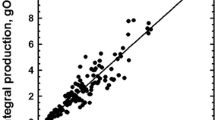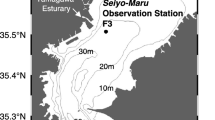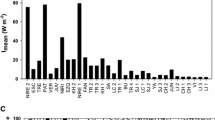Summary
A review of the literature on phytoplankton primary production studies in lakes indicates that in most cases the daily primary production rates have been derived by multiplying the short-term (usually 3 or 4 hours) production measurement with a light factor. This factor is a ratio between the total irradiance during the day and during the period of incubation. The aim of the present study was to verify this method of calculation. Since the primary production rate is of great importance for the carbon cycle of lakes, this study can be regarded as a fundamental contribution to the integrated research of the ecosystem of lake Vechten (the Netherlands) (BESTet al., 1978).
Photosynthetic carbon fixation was determined using the radiocarbon method of STEEMANN NIELSEN (1952). Thein situ measurements were carried out for 2 hours incubation periods starting at 15–30 minutes before sunrise and ending 15–30 minutes after sunset. Also measured were: water temperature, light penetration, oxygen and chlorophyll. Total incident solar radiation data were obtained from the Royal Netherlands Meteorological Institute (K.N.M.I.) at de Bilt (situated at 5 km from lake Vechten). The production during two consecutive 2-hourly periods,e.g. period 1 and period 2, were summed up and using the irradiance data during the 4 hours, daily production was calculated. These calculations were repeated for period 2 and 3, and so on. The sum of all the short-term measurements during a day,i.e. the total daily primary production, was taken for comparison with the production calculated by using the sum of the production during two successive periods and the light factor.
Daily production rates obtained by extrapolating from short-term incubation periods both in the morning and in the late afternoon appeared to overestimate the ‘real’ daily production (Fig. 1) up to 100%. It is likely, that in the morning the lack of nutrient limitation and relatively better physiological state of algae, and in the afternoon increase of phytoplankton biomass during the day can be considered as the factors causing the discrepancy between the calculated and ‘real’ production. On the other hand, the underestimation of daily production rate based on midday time intervals on sunny days, was about 25%. It is attributed to photoinhibition, especially in the present study where the measurements were limited to the upper water strata (0–4m).
Is is concluded that short-termin situ exposures between 10.00 and 14.00 hr appeared to be a good indicator of total primary production, although underestimates up to 25% on sunny days are to be taken into account.
Similar content being viewed by others
References
BEST, P.H., MARIANNE C.I. BLAAUBOER, Th.E. CAPPENBERG et al., 1978. Towards an integrated study of the ecosystem of lake Vechten. Hydrobiol. Bull. Amsterdam, 12:107–118.
STEEMANN NIELSEN, E., 1952. The use of radio-active carbon (C14) for measuring organic production in the sea. J. Conseil, 18:117–140.
Author information
Authors and Affiliations
Rights and permissions
About this article
Cite this article
Opstelten, W. Diel patterns of phytoplankton productivity in Lake Vechten. Hydrobiological Bulletin 14, 219–220 (1980). https://doi.org/10.1007/BF02260126
Published:
Issue Date:
DOI: https://doi.org/10.1007/BF02260126




